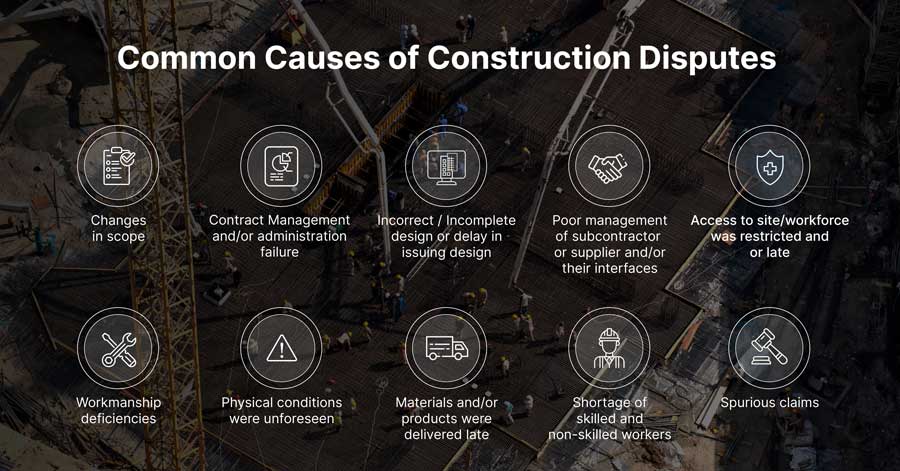
Construction disputes are inevitable on any construction site.
Whether it’s an argument between owner and contractor over contractual obligations, the GC (General Contractor) & Architect argue about design errors or payment for work completed – conflict can be hard to avoid when not handled efficiently at a high-level project level.
Moreover when not handled efficiently on the project level, construction-site disagreements can morph into formal disputes and expensive legal battles.
Globally, it costs the construction industry an average of $54.26m per formal dispute and 13.4 months to reach a resolution, according to the 2020 Global Construction Disputes Report by Arcadis.
Together with research completed internally, as of 2022, revealed that the estimated impact of disputes is approximate €125 billion

In fact, some of the main causes of construction disputes includes workmanship deficiencies, unforeseen physical circumstances that cause delays, poor project management and delay in issuing designs among many others as highlighted in the figure below.

When disputes are not resolved efficiently, the potential negative impacts cannot be understated. The effects of construction disputes in an organization can be summarised as follows:
One of the most common causes of litigation is when a contractor fails to pay the workers for their work, and then the employer takes them to court. Moreover, the entire litigation process not only sucks up time for the construction project but also costs are diverted to litigation fees.
Ambiguities in the prevailing contract forms eventually make contract forms difficult and cause impacts such as an increase in the number and frequency of claims and disputes.
Likewise, disputes and their respective resolution processes halt construction progress, thereby causing a delay in the time ought to be taken for the construction
No part of the project team intends to get into a dispute as a project is beginning. Nevertheless, in case any form of dispute arises, funds must be diverted to facilitate the dispute resolution process. As a result of not having preventative solutions in place included in the original budget, cost overruns will occur.
Not to mention, delays that arise due to disputes can also impact the cost of construction materials that are dependent on the market price dynamics. Besides, in most cases, the cost of materials always changes in the upward direction with respect to inflation.
In construction arbitrations involving delay and disruption, claims for lost overheads and profit are common. By the same token, contractors will claim a refund for the loss of profits incurred during the time resolution.
Besides, coupled with other effects of disputes in an organization include; insurance coverage, liability risk exposure, additional expense in managerial and administration, and loss of business viability
Having a construction camera on the job site has become an invaluable tool considering the amount of money that ends up in arbitration that would have otherwise been used for construction. Not to mention, construction is a high-value industry, so when things go wrong it’s expensive.
Having the full archive of video footage helps project teams save money and resolve disputes.
Furthermore, some of the disputes that a construction camera can help to avoid are in the table below:
| Top Causes of Claim or Dispute | Can Evercam Influence? |
| Change in scope | NO |
| Contract interpretation issues | NO |
| Contract management and/or administration failure | YES |
| Design information was issued late | NO |
| Poor management of subcontractor/supplier and/or their interfaces | YES |
| Physical conditions were unforeseen | YES |
| Access to site/workforce was restricted and/or late | YES |
| Workmanship deficiencies | YES |
| Level of skill and/or experience | NO |
| Claims were spurious | YES |
| Operational performance | YES |
| Tender errors and/or inaccurate estimates | NO |
| Materials and/or products were delivered late | YES |
| Shortage of skilled and non-skilled workers | YES |
| Installation failure | YES |
| Weather conditions were exceptionally adverse | YES |
| Personality and/or cultural differences | NO |
| Bias and/or failure to cooperate | NO |
Additionally, 40% of the causes of construction disputes can be avoided with the installation of a construction camera. This amounts to approximately $54 billion.

Hence, with construction camera on a job site helps keep employees, subcontractors, delivery drivers, and others focused on safety and compliance. This helps to avoid any incidents that may occur and lead to disputes and saves the cost of dispute resolution.
Evercam construction cameras have a Live View feature which enables team members to remotely monitor construction projects. This 24/7 visibility ensures that communication of change orders is faster compared to physically visiting the site first. In addition, this results in fewer delays that may end up causing any form of dispute.
Everything that happens on a construction site is recorded in high resolution and saved in the cloud for future reference. As a matter of fact, this is what one of our clients had to say about this feature after being served with a claim for faulty equipment.
“An equipment manufacturer filed a damage claim alleging that we were responsible for tire damage on a boom lift that we rented for four days 40 days prior.”
I used a zoomed-in video recording of the day the boom lift was dropped off and drew a circle on the tire with the Edit Tool to prove that it was damaged before it ever arrived on the project site.”
Lastly, to decrease the occurrence of disputes in a project, dispute avoidance strategies have to be used such as stakeholder management, of course, early involvement in the decision-making process, lean construction, and the use of construction cameras to monitor the progress of construction.